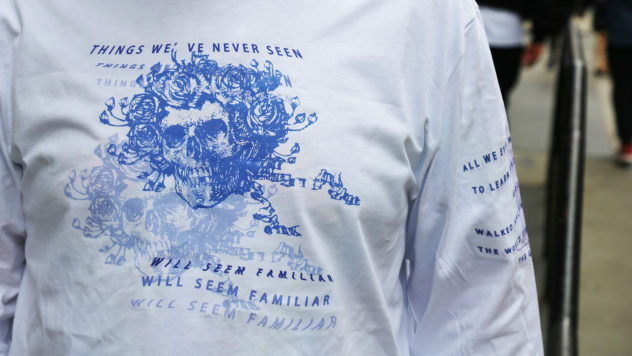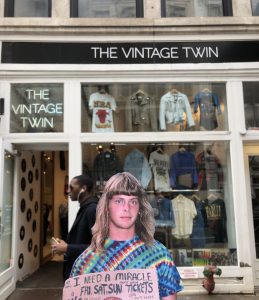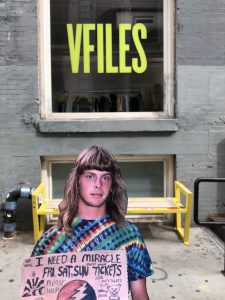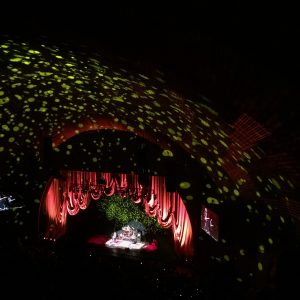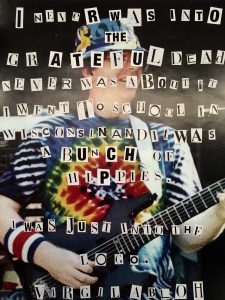Over the weekend, I paid a visit to one of the most famous music venues in America — New York’s Radio City Music Hall. In October of 1980, at the age of 21, my father would take the train from Boston to New York City in hopes of securing a miracle ticket to one of the Grateful Dead’s eight shows at the acclaimed music hall. Flash forward thirty-eight years later, and there I stood outside the very same venue, on the second night of Bob Weir and Phil Lesh’s duo tour. Unlike my father, however, I did not have my sights set on a miracle ticket. Instead, I was in search of two concert-goers who might be willing to let me interview them.
I rode the F train from sixth avenue and 14th street to Rockefeller Center. I arrived at the site no later than six o’ clock, which would give me an hour or so to interact with prospective show attendees before Radio City would open the floodgates and welcome a sea of zealous Deadheads into the historical space. Because I am innately terrible at initiating social interactions, I decided to print out a sign prior to my arrival; this sign read, “FASHION STUDENT CONDUCTING RESEARCH ON THE GRATEFUL DEAD. PLEASE LET ME TALK TO YOU!” And so, I stood proudly under the marquee, sign dangling in my hands, eagerly anticipating my first willing participant. I immediately attracted a lot of attention; after all, I consciously chose not to conform to the unofficial Deadhead dress code. Instead of wearing a bootleg tour t-shirt or an assortment of tie-dyed accoutrements, I opted for a white, puff-sleeve blouse (think: season five, episode two of Seinfeld), gingham trousers, and fuchsia platform sandals. Many passerby stopped to read my sign, but few seemed willing to participate in my elusive proposition. No more than twenty minutes after my initial arrival at the scene, I was approached by a man who must’ve been in his early sixties. After catching sight of my sign, he abruptly stopped in his tracks, lingered for a moment, before approaching me. “Fashion student conducting research on the Grateful Dead,”, echoing the phrase emblazoned on my poster, “what’s that all about?” Because I did not want to sway my interviewees in any way, I told them that I would elaborate on the purpose of my research after they answered a few questions. Luckily, my first inquirer obliged.
INTERVIEW ONE: JIM DALEY, THE TAPER
Me: First off, could you start by telling me your name?
Jim: My name’s Jim.
Me: And I’m assuming you’re here for the show tonight, right?
Jim: Correct. Are you?
Me: No, no. Just here to talk to people. I don’t have a ticket.
Jim: Maybe you’ll get a miracle ticket.
Me: I don’t have any money anyways. I’m just happy to talk to people.
Jim: A “miracle” ticket means it’s free.
Me: Oh, I didn’t know that.
[NOTE: A “miracle” ticket is a popular term amongst the Deadhead community. The terminology is a product of the Grateful Dead song, “I Need a Miracle.” It’s not uncommon to see dozens of hopeful fans standing out shows with a sign that reads, “I need a miracle”, waving one finger in the air. My first experience with this term was when I went to see the Dead in Chicago for the 50-year reunion shows. Because scoring a ticket to those shows in particular was nearly impossible, I assumed “miracle” simply referred to any ticket at all, and that anyone hoping for a miracle was willing to pay anything for a ticket. I didn’t realize “miracle” implied free.
Me: So, did you actually tour with the Dead when they were still a band?
Jim: I wouldn’t say I “toured” with them. I followed them around for about a decade, though.
Me: Right, that’s what I meant. When were you following them?
Jim: Pretty much throughout the eighties. Started in the late seventies, continued throughout the eighties.
Me: What was your first show?
Jim: Englishtown. 1977.
Me: Raceway Park! No way! That’s my favorite show of all time–
[A friend of Jim briefly interrupts us, and Jim subsequently introduces us to each other]
Jim: Yeah, so during the eighties, I was following the Dead on tour, and I was a taper. I was one of the guys taping all the shows I went to, through 1989. I just wrote a book on it, actually.
[Jim hands me his business card]
Me: Wow, that’s incredible. Um, I feel like I should probably explain myself now. I’m here because I’m working on a long-term research project on the relationship between the Grateful Dead and the fashion industry. So I want to ask you, do you have any recollection of what kinds of things people were wearing to Dead shows back in the eighties?
Jim: Tie-dye. Lots of tie-dye.
Me: Right, of course. But when you go to shows now — whether’s it’s Phil & Friends, Furthur, Dead & Company — do you notice a difference in how people dress for the shows now in comparison to how people dressed back then?
Jim: Not at all. Look around. It’s all the same. Still the same look. There’s always been a distinct style amongst Deadheads. That hasn’t changed. It’s all about the culture. It hasn’t changed at all.
Me: Right. So you don’t think the culture has shifted at all? Do you think people still come out to these shows for the same reasons they came out thirty years ago?
Jim: Absolutely. It hasn’t changed at all.
Me: Interesting.
Jim: So what exactly are you researching?
Me: Well, I’m a student at Parsons, and I’m working on a research project where I’m investigating the relationship between the Grateful Dead and the fashion industry. I basically came here with the intent of finding someone on the older side, who might’ve toured with the Dead and could tell me a bit about what kind of styles people wore during the actual Grateful Dead-era, and then hopefully I can find someone a bit younger too, ideally someone who discovered the Dead through Dead & Company and might know something about the relationship between these two worlds.
Jim: Well, I doubt you’ll find that.
Me: I don’t know, it might be hard to find, but I think it could happen. There are some people out there who only just discovered this music.
[Our conversation is interrupted again by the aforementioned friend]
Jim: Well, we’re going to get in line. But check out my book. Look it up on Amazon. Search “Grateful Memories”. It’ll come right up.
Me: I will. Of course. Thanks so much. Enjoy the show, by the way.
Jim: Great to meet you. And good luck with your project.
From my interview with Jim, I could sense that he wasn’t entirely convinced that I had any prior knowledge of Deadhead culture. I have no doubt that his assumption was heavily engendered by my appearance, which only further illustrates my point. People are always surprised to learn that I love the Grateful Dead, and it’s in no small part due to the fact that my appearance or manner of dress does not align with the collective visual identity of this subculture. I have attended countless Dead shows by myself, and people (mostly men) constantly assume I’m there with my Deadhead boyfriend. They cannot fathom the idea that someone who dresses the way I do might actually know a thing or two about the music. There was one time where I actually did attend a Dead & Company show with a guy I was seeing. He knew not a single song by the Dead, nor was he familiar with what kind of crowd typically attends a Dead show (he could not believe his eyes when, after the show, hundreds of fans, clad in tie-dye and “stealie” tees, loitered outside Madison Square Garden, ingesting copious amounts of nitrous oxide by way of colorful balloons). However, he did fit the unwritten dress code more so than myself. He wore a t-shirt and bandana, meanwhile, I was sporting a pair of five inch heels and yet another over-the-top white blouse. The men sitting next to us at the show, who arrived four songs into the first set, turned to us and inquired about what songs they’d missed. “Hell in a Bucket, Cold Rain & Snow, and Me & My Uncle” I promptly responded, but they proceeded to ignore me. They wanted to hear it from the guy I was with. During the set break, they tried to talk to him about Jerry Garcia and what it was like to tour with the Dead in the eighties. Any time I tried to interject, they wouldn’t listen. They simply assumed I knew nothing, and that of course my more appropriately-dressed counterpart was the true Deadhead, which couldn’t be further from the truth.
My reason for sharing the aforementioned vignette is to suggest that, despite the sheer number of Deadheads I spoke to who were completely dismissive of the role that fashion plays within this subculture, it does in fact play a huge role. If people are genuinely shocked to learn that a girl who wears five inch heels and leopard print coats can easily distinguish between a 1972 live version of “Brown Eyed Women” and a 1977 “Brown Eyed Women”, is that not a testament to the importance of visual identity within this subgroup? The role that clothes play is an interesting one, though. The typical “Deadhead” dresses in a very particular manner, but this mode of dressing is never an attempt to appear inherently stylish. Deadheads are not pairing tie-dye camisoles with floral-print maxi skirts and subsequently asking themselves, “is this on trend?” It’s all about immersing oneself in this niche culture. The sartorial decisions of Deadheads (or, at least, first-generation Deadheads) are independent of the world of high fashion.
Shortly after concluding my interview with Jim, I was approached by another man, probably in his late fifties or so. He wore a plain red t-shirt and dark-wash denim jeans. Like Jim, he too inquired about my sign. I simply stated that I was a student at Parsons conducting research on the Dead, and that I came to Radio City in search of potential interviewees. He immediately volunteered.
INTERVIEW NUMBER TWO: PHIL, THE NON-DEADHEAD
Me: Could you start by telling me your name?
Phil: Phil. And what’s yours?
Me: Annabelle. Nice to meet you, Phil. Very fitting name. Are you going to the show tonight?
Phil: I am. Are you?
Me: No, no ticket. I’m just here to talk to people like yourself. So, did you follow the Dead on tour back when Jerry was still in the picture?
Phil: No, no. I’m not even a Deadhead. I don’t consider myself one.
Me: You’re very quick to dismiss the label of “Deadhead”. Is that because of the implications?
Phil: No, I mean, I just didn’t follow them around back in the day. My first show was in 1982, at the Jamaica World Music Festival. It was a three-day festival. That was the only time I saw the Dead with Jerry. I didn’t follow them around.
Me: Okay, fair enough. But you go to shows now, Post-Jerry? You know, cover bands, or Dead & Company, for example?
Phil: Yes.
Me: And when you go to these shows, are you paying attention to what people are wearing? I mean, do you notice any commonalities amongst Deadheads in regards to what they’re wearing?
Phil: Here’s the thing. It’s not about the fashion. There’s nothing fashionable about Deadheads. It’s all about the vibe. We’re not here for fashion. It’s about the music and the vibe. These people don’t care about fashion.
Me: Right. So, would you be surprised then, if I told you that there’s a handful of fashion designers who are now appropriating Grateful Dead iconography and using it in their collections? If you don’t think Deadheads care about fashion, do you find it strange that the fashion industry is suddenly invested in this subculture?
Phil: Wow. Who’s doing that?
Me: One of the designers is Virgil Abloh. He’s the creative director of Off-White. Jonathan Anderson, too.
Phil: I don’t even know who those people are. [laughs]
Me: Yeah, that’s actually sort of my point. These are my two worlds — Grateful Dead and fashion. I’ve always seen them as two distinctly different worlds, and suddenly they’re sort of merging, but there’s still such a disconnect. The fashion industry is invested in the culture, but only on a superficial level. And then, Deadheads, for the most part, don’t pay any attention to fashion.
Phil: That’s a very interesting discussion. Yeah. These people aren’t fashionable. Look at them! These people come to the show for the vibes. It’s all about the vibes.
Me: So you don’t think there’s a distinct visual identity amongst this group of people? Even if they’re not inherently stylish?
Phil: That’s it. That’s the identity. People who aren’t inherently fashionable [laughs]. These are just good people who connect through music.
Me: Right, of course. Some of the best people in the world, really. I guess that’s why I feel a bit conflicted about the sudden convergence of these two worlds. I have to wonder whether or not it’s actually genuine.
Phil: Yeah. I don’t know. It’s interesting, though.
Annabelle: Thanks so much for letting me pick your brain, Phil. I’m going to let you go now since you’re probably itching to get in line. But I hope you have a great time at the show!
Phil: Thanks. It was great to meet you.
Towards the end of my conversation with Phil, I had yet another man approach me. This man looked much younger than my other two interviewees. I figured he might’ve been in his late twenties or perhaps his early thirties. Interestingly, he was dressed a bit differently than most of the older folks. He wore a bright green anorak and cuffed jeans. His ensemble was not unlike the outfits worn by the young twenty-somethings who often attend my dad’s band’s gigs. Even so, I wasn’t immediately sure whether he was going to the show that night, or if he was just a random passerby who got caught up in the crowd. However, he too was curious about what exactly I was researching. I gave him the same spiel, and he subsequently agreed to an interview.
Me: Alright, what’s your name?
Ricky: Ricky. And yours?
Me: Annabelle. It’s nice to meet you, Ricky. Are you here for the show tonight?
Ricky: Yeah, are you?
Me: No. Just here to talk to people. So I want to start by asking you, when did you first get into the Dead?
Ricky: 2009. I was a freshman in college. But my parents were Deadheads. Becoming apart of this world was sort of inevitable.
Me: Nice, yeah. Same here. So, do you go to shows often? Dead & Company, Dark Star Orchestra…
Ricky: Yeah, for sure. I try to go to as many shows as I can.
Me: And when you go to these shows, do you pay any attention to what people are wearing? Do you notice any overwhelming styles or trends amongst Deadheads?
Ricky: I don’t know. I don’t pay much attention to that.
Me: So do you think that notion of visual identity or style is important to Deadheads? Do you think people consciously dress for these shows?
Ricky: No, because it’s not about that. Going to these shows, it’s about the vibe that you bring. It’s not about the fashion or style, it’s about the music and the vibes and the energy. The music and this culture… it transcends any sort of description you try to encapsulate it with. It’s its very own subculture, really.
Me: So, to you, it’s not about fashion. Would you be surprised, then, if I told you that there a handful of fashion designers right now who are appropriating Grateful Dead iconography?
Ricky: No, not at all. It’s all connected. Art, music, fashion. They’re all connected. Art is art.
Me: But do you view that as a bad thing? The whole appropriation aspect, that is. Here are these designers who are appropriating this iconography, meanwhile, many of them will openly admit that they know nothing about the actual culture of the Grateful Dead. Virgil Abloh, for example, put a stealie on a t-shirt and incorporated it into his first collection for Off-White, but then proceeded to state in an interview that he never cared for the Dead.
Ricky: Yeah, I mean, of course, there are going to be cases where [designers] are just exploiting [the imagery] for money. Happens all the time. Anything to make a quick buck. But it’s not bad, no. Not at all. Anyone can partake in this culture. That’s what it’s all about. It’s all about inclusion. So if these fashion people wanna take part in that, they’re welcome to. With [Deadheads], it’s all about loving each other. There’s no room for negativity.
Me: I really admire your positivity. It’s made me reconsider my view on this whole thing.
[a security guard very abruptly interrupts the interview and proceeds to reprimand Ricky for very openly holding a joint in front of the doors of the venue]
Me: I’ll let you go now.
Ricky: Yeah, I’ve gotta go smoke this across the street so I don’t get in trouble. But good luck with your project.
My conversation with Ricky was my final formal interview, however, I spoke to a handful of other insightful concert-goers. Most everyone had only positive things to say. I was genuinely surprised; none of the people I spoke to viewed the appropriation of the iconography as an inherently bad thing. Nobody seemed to notice any cultural shifts amongst Deadheads within the past few years. According to all accounts, the dress code has remained unchanged and it seems that the fashion industry’s sudden interest in Deadhead culture has no overwhelming effect on the people who identify with this culture.
Just as I was wrapping up another conversation, I was approached once more by Phil, the self-identifying Non-Deadhead.
“Ready for the show?”, he asked me.
“Oh, I don’t have a ticket, remember?” I responded.
Phil then proceeded to introduce me to a man named Keith — a high school history teacher from New Jersey who followed the Dead around in the late seventies and eighties. I shook Keith’s hand and introduced myself.
“Keith has your ticket,” Phil said.
I reminded him once more that I had no money, and both men shook their heads. It was in that moment that I realized my conversation with Jim the Taper might’ve been somewhat prophetic:
I had secured a miracle ticket.
Keith’s only request in return for the ticket was that I pass on the kindness to someone else. His requisite is perhaps the most accurate reflection of the ethos of Deadheads. They are truly the kindest, most genuine beings. There’s a line from a Dead song (“Scarlet Begonias”) — “strangers stopping strangers just to shake their hands”. This is quite literally what happens at Dead shows. By the end of the night, strangers become best friends. A person you’d never spoken to prior to the first set will feel like a lifelong friend by intermission. By the end of the night, I’d spoken to over a dozen strangers, danced and sang with a handful, hugged people whose names I can’t even remember. As I sat in the subway station after the show waiting for the F train, I couldn’t help but laugh at myself for expecting these people to be outraged by what’s going on with regards to the world of high fashion and the Dead. Of course, they wouldn’t be. These people are far too happy to demonstrate any degree of disappointment with aspects of their culture being supposedly appropriated by external agents.
That being said, perhaps they don’t mind simply because this notion of appropriation bears no significant influence on their lives. Deadheads, for the most part, are so removed from the world of fashion (this is, of course, a broad generalization, as I’m sure there are countless listeners who are also involved in the world of fashion) that anything that goes on within that industry does not affect them. However, as someone who is so deeply invested in both worlds, I do still feel frustrated (and, more than anything else, conflicted) by this idea. And again, I can’t help but observe the sheer disconnect between these two systems. If Jerry Garcia is the figurehead of this subculture, then one might suggest that Anna Wintour assumes the same role for the world of fashion — and these two people couldn’t be more dissimilar. While Jerry was known for his kindness and compassion, Anna is known for her aloof nature. I’ve been to Dead shows, and I’ve been to fashion shows. The crowds are pretty much diametrically opposed, with Deadheads collectively assuming a similar demeanor to Garcia and sartorialists often emitting the same haughty air as Ms. Wintour (again, a generalization). Tie-dye is to Deadheads as Birkin bags are to fashion editors.
With all that in mind, I’m not entirely sure what direction I’m headed in with regards to my research. However, it’s worth noting that conducting this on-site investigation left me feeling more inspired than ever.






















